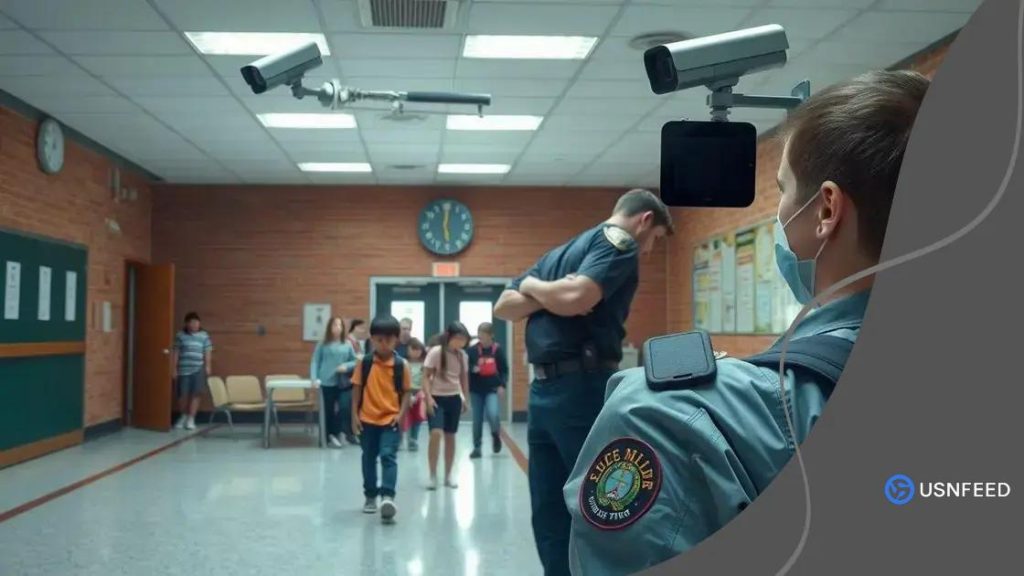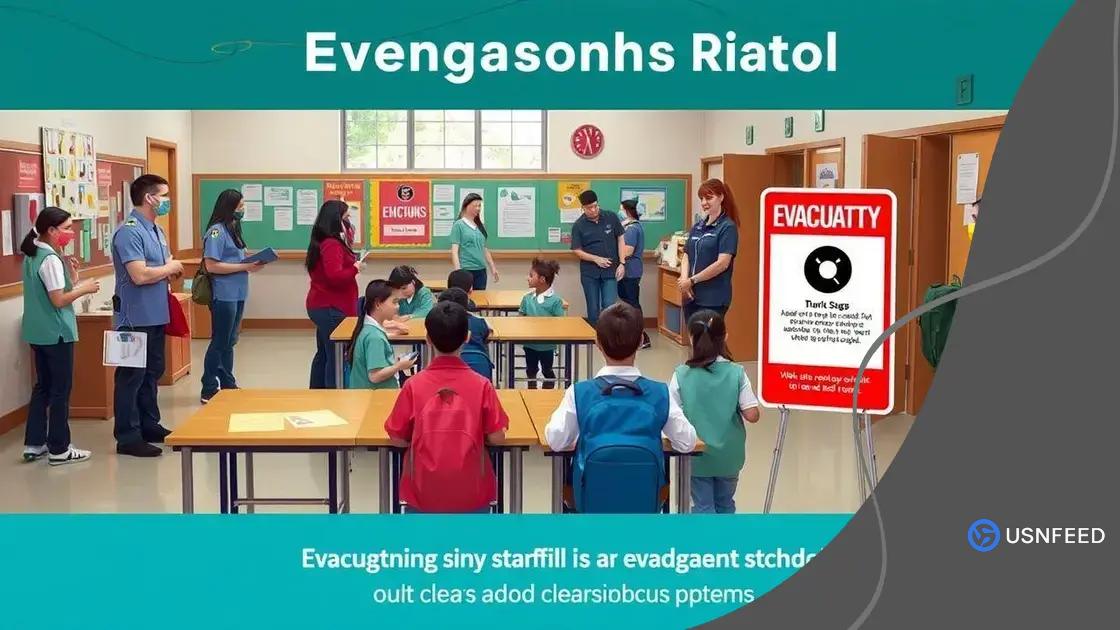School safety and security measures: Essential strategies

Effective school safety and security measures include engaging parents, training staff, clear emergency response plans, and utilizing technology to create a safe environment for students and staff.
School safety and security measures play a vital role in ensuring the well-being of students. Have you ever wondered how these measures can impact the daily life of a student? Let’s explore key strategies and insights.
Understanding the importance of school safety
Understanding the importance of school safety is vital for creating an environment where students can thrive. When students feel safe, they can focus better on their studies and personal growth.
Why School Safety Matters
School safety measures protect not only students but staff and visitors too. These practices help in preventing emergencies and minimizing the risk during unexpected situations.
- Reduces the likelihood of accidents;
- Supports mental health and well-being;
- Enhances student learning and focus;
- Promotes a positive school culture.
Implementing strong safety protocols helps schools remain prepared for various scenarios. It is essential that schools not only establish these measures but also communicate them effectively to everyone involved.
Key Components of Effective School Safety
Some effective safety components include surveillance systems, trained security personnel, and clear emergency procedures. Each of these elements plays a crucial role in creating a comprehensive safety plan.
- Surveillance cameras monitor activity in and around the school.
- Security personnel ensure a presence that deters unwanted behavior.
- Emergency procedures must be practiced regularly to ensure everyone knows their role during a crisis.
Investing in school safety is not just about preventing issues; it’s about fostering a supportive learning environment. Collaboration among teachers, parents, and the community is vital for ongoing improvements in safety measures, providing a foundation for a trustworthy school community.
Key security measures for schools today
Implementing key security measures for schools today is essential to foster a safe learning environment. Effective security protocols can prevent emergencies and provide peace of mind for students and parents alike.
Essential Security Measures
Schools should adopt various security measures to ensure safety. Some common practices include having a secure entry system, regular safety drills, and clear communication protocols. Each of these components contributes significantly to a safer school atmosphere.
- Secure entry systems limit access to authorized personnel.
- Regular safety drills prepare students and staff for emergencies.
- Clear communication protocols ensure everyone knows who to contact in case of an emergency.
In addition to these measures, schools should invest in physical security features. These features help create barriers against potential threats while ensuring a welcoming environment for students.
Technology in School Security
Utilizing technology enhances security efforts substantially. Surveillance cameras, alarm systems, and access control solutions are vital. They not only deter potential threats but also provide valuable records in case of incidents.
- Surveillance cameras monitor activities throughout the school.
- Alarm systems trigger alerts during emergencies.
- Access control solutions prevent unauthorized entries.
Furthermore, training staff on how to handle security concerns is critical. This empowers them to act swiftly and effectively in any situation, keeping students safe.
Creating an emergency response plan

Creating an emergency response plan is crucial for ensuring the safety of students and staff in any school. A well-thought-out plan prepares everyone for unexpected situations, helping to minimize panic and confusion.
Key Elements of an Emergency Response Plan
Every effective emergency response plan should include several key components. These components help outline actions to be taken during an emergency, ensuring everyone knows their roles and responsibilities.
- Clear communication channels for alerts and updates.
- Designated roles for staff and volunteers during emergencies.
- Evacuation routes and meeting points.
- Regular drills to practice the plan.
By incorporating these elements, schools can create a comprehensive plan that effectively addresses various scenarios. Moreover, planning for different types of emergencies enhances readiness and boosts confidence among staff and students.
Training and Drills
Training staff is essential to the success of any emergency response plan. Staff should understand the specific procedures to follow in different situations, whether it involves a natural disaster, a security threat, or a medical emergency. Regular drills ensure that everyone is familiar with the protocols.
- Hold fire drills monthly to practice evacuation routes.
- Conduct lockdown drills to prepare for security threats.
- Review emergency protocols regularly in staff meetings.
In addition to staff training, involving students in emergency drills reinforces their understanding and prepares them to act calmly during real emergencies. Open discussions about safety and encouraging students to ask questions foster a culture of awareness and responsibility.
Engaging parents and the community in safety
Engaging parents and the community in safety efforts is vital for creating a comprehensive school safety plan. When parents are involved, they support the school’s initiatives, helping to foster a culture of safety.
Benefits of Parental Involvement
When parents engage in school safety programs, it reinforces the importance of safety at home and in school. Parents can offer valuable feedback and guidance, enhancing the effectiveness of safety measures.
- Builds trust between parents and school staff.
- Increases awareness of safety protocols at home.
- Encourages a unified approach to handling emergencies.
Moreover, when parents understand safety plans, they are more likely to communicate these practices to their children. This creates a ripple effect, ensuring that students prioritize safety both at home and in school.
Community Partnerships
Building strong relationships with local organizations enhances safety initiatives. Collaborating with law enforcement, fire departments, and health services creates a network of support that benefits the school. These partnerships can also provide resources for training and materials.
- Facilitates access to safety workshops and training sessions.
- Offers support during community safety events.
- Acts as a bridge between schools and emergency services.
Additionally, hosting events that involve parents and community members can significantly promote safety awareness. Schools can organize safety fairs, where experts discuss best practices. This not only educates everyone involved but also strengthens the bonds within the community, creating a safer environment for all.
Training staff on security protocols
Training staff on security protocols is essential for maintaining a safe school environment. When teachers and staff are well-prepared, they can respond effectively during emergencies, ensuring the safety of all students.
The Importance of Training
Every school should prioritize regular training sessions for staff on various security protocols. This training provides staff with the knowledge and skills to manage potential threats and respond to emergencies calmly.
- Prepares staff for different types of emergencies.
- Increases confidence in handling difficult situations.
- Fosters a culture of safety within the school.
Staff should be made aware of specific procedures, such as lockdowns, evacuations, and communication methods. Knowing these protocols creates a solid foundation for maintaining safety.
Components of Effective Training
Effective training programs include hands-on practice and discussions about real-life scenarios. Role-playing exercises allow staff to experience emergency situations in a controlled environment. This practice helps them remain calm and act decisively when an actual crisis occurs.
- Simulated drills for different emergencies.
- Clear guidelines for communication during a crisis.
- Regular updates on new safety measures and protocols.
Documenting the procedures and providing quick reference materials can also be helpful. This allows staff to refresh their knowledge and stay informed about any changes in security measures.
FAQ – Frequently Asked Questions about School Safety Measures
Why is engaging parents important for school safety?
Engaging parents fosters trust and collaboration, allowing for a unified approach to safety and enhancing communication about protocols.
What key components should be included in an emergency response plan?
An emergency response plan should include clear communication channels, designated roles for staff, evacuation routes, and regular training drills.
How often should staff training on security protocols occur?
Staff training should occur regularly, ideally at least once or twice a year, to ensure everyone is familiar with the latest safety procedures.
What role does technology play in school safety?
Technology enhances safety by providing tools such as surveillance cameras and alarm systems, which help monitor and respond to potential threats effectively.